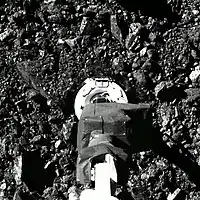| Discovery[1][2] | |
|---|---|
| Discovered by | Dedrick et al. |
| Discovery date | 2020 |
| Radial velocity | |
| Designations | |
| HD 97101 Ac, HIP 54646 c[3] | |
| Orbital characteristics | |
| 1.43±0.06 AU[2] | |
| Eccentricity | 0.093+0.1 −0.064[2] |
| 748.3+1.3 −1.2 d[2] | |
| 74°+74° −200°[2] | |
| Star | GJ 414 A |
| Physical characteristics | |
Mean radius | 8.78+4.03 −2.66 R🜨 (0.783+0.359 −0.237 RJ)[2] |
| Mass | 56.27+10.43 −9.91 M🜨 (0.177+0.03 −0.031 MJ)[2] |
| Temperature | 123.3±13.2 K (−149.7 °C (−237.5 °F))[2][lower-alpha 1] |
Gliese 414 Ac, or GJ 414 Ac, is an exoplanet located 39 light-years from Earth, in the constellation Ursa Major.[4][5] It is at least 56 times more massive and about 9 times larger than the Earth.[2] It orbits its parent star at a distance of 1.43 astronomical units and completes one revolution every 2 years and 18 days.[2]
It is a potential candidate for future direct imaging missions.[3]
Characteristics
Gliese 414 Ac is a super-Neptune exoplanet.[2][3] It is 8.78 times larger than Earth, but 21.7% smaller than Jupiter. Its minimum mass is 56.27 M🜨.[2]
Orbital characteristics
Gliese 414 Ac completes an orbit around its star every two years and 18 days, and is 1.43 astronomical units (214,000,000 km) away from it.[2]
Due to its large separation, the planet is frigid, with an planetary equilibrium temperature of −150 °C (−238 °F)[2][lower-alpha 1], that is comparable to Saturn, which has a temperature of -140°C.[6]
Discovery
Gliese 414 Ac was discovered in 2020 by analyzing radial velocity data from Keck's HIRES instrument and the Automated Planet Finder at Lick Observatory, as well as photometric data from KELT.[3]
Host star
Gliese 414 Ac orbits an orange dwarf about 70% the size of the Sun.[4] The star also hosts another exoplanet, called Gliese 414 Ab, a Sub-Neptune that orbits it 6 times closer than the outermost planet, at a distance of 0.24 AU.[2]
In addition to a planetary system, it also has a red dwarf companion star, that is 408 astronomical units distant.[3]
Notes and references
- ↑ Martin, Pierre-Yves (2020). "Planet GJ 414 A b". Extrasolar Planets Encyclopaedia. Retrieved 2023-12-14.
- 1 2 3 4 5 6 7 8 9 10 11 12 13 14 15 Dedrick, Cayla M.; Fulton, Benjamin J.; Knutson, Heather A.; Howard, Andrew W.; Beatty, Thomas G.; Cargile, Phillip A.; Gaudi, B. Scott; Hirsch, Lea A.; Kuhn, Rudolf B.; Lund, Michael B.; James, David J.; Kosiarek, Molly R.; Pepper, Joshua; Petigura, Erik A.; Rodriguez, Joseph E. (2021-02-01). "Two Planets Straddling the Habitable Zone of The Nearby K Dwarf Gl 414A". The Astronomical Journal. 161 (2): 86. arXiv:2009.06503. Bibcode:2021AJ....161...86D. doi:10.3847/1538-3881/abd0ef. ISSN 0004-6256.
- 1 2 3 4 5 "Open Exoplanet Catalogue - Gliese 414 Ab". www.openexoplanetcatalogue.com. Retrieved 2023-12-14.
- 1 2 "Gliese 414 | NASA Exoplanet Archive". exoplanetarchive.ipac.caltech.edu. Retrieved 2023-12-14.
- ↑ "Find the constellation which contains given sky coordinates". djm.cc. Retrieved 2023-12-14.
- ↑ "Solar System Temperatures - NASA Science". science.nasa.gov. Retrieved 2023-12-14.
- 1 2 Assuming a bond albedo of 0.343, the same as Saturn.


_on_Jul_14_2020_aligned_to_stars.jpg.webp)